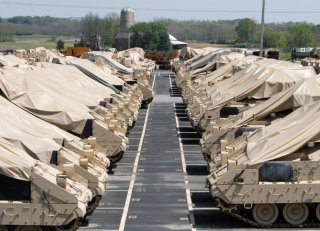This Gulf War Tank Will Never Be Replaced
Some 2,200 Bradley vehicles were deployed during Operation Desert Storm, and only three were lost to enemy fire.
Here's What You Need to Remember: The U.S. military had sought to replace the M2 Bradley twice before and in the process has spent $20 billion to develop a replacement. As a result the Bradley will likely remain in service for at least another decade.
Named after U.S. General Omar Bradley, this vehicle was developed to address the Soviet Red Army's new era of APCs, notably the BMP-1 (Boyevaya Mashina Pekhoty 1) or "infantry fighting vehicle," which was a drastic change in Soviet armored warfare doctrine. As the first mass-produced infantry fighting vehicle deployed by the Soviet military, the BMP-1 combined the properties of an APC with those of a light tank. It also provided a way for infantry to operate from the relative safety of its armored, radiation-shielded interior and to fight alongside the vehicle in uncontaminated areas. The BMP-1 offered mobility along with fire support and unlike earlier APCs, it was also able to fight alongside main battle tanks.
By contrast, the U.S. Army relied on World War II-style half-tracks and the Vietnam War-era M113 APC to deliver troops to the edge of a battle zone. After seeing the potential of the BMP-1 when it was used by Egyptian and Syrian forces in the 1973 Yom Kippur War and in the early stages of the Soviet-Afghan War, U.S. planners were convinced that a similar vehicle was needed to confront the Soviet threat in Europe.
Instead of an APC, which would just transport troops to the front lines, the new vehicle began as part of the Mechanized Infantry Combat Vehicle (MICV), which could also allow the soldiers to fight from inside the vehicle as needed. The MICV program that was soon merged with the Armored Reconnaissance Scout Vehicle program, as these had similar requirements for a new light armored vehicle. However, that required the addition of a turret with a 25mm M252 Bushmaster chain gun, 7.62mm M2440 machine gun and BGM-71 TOW anti-tank missiles.
With the added armaments the M2 required a crew of three including the commander, gunner and driver, but only had the capacity to carry six fully equipped soldiers.
The M2 was designed to provide protection for those inside from small arms fire and artillery, as well as TOW or Stinger missiles. The troop compartment was also designed with six external firing ports – two on each side and two on the passenger ramp.
The M2 Bradley entered service in 1981, replacing the M113, while at the same time the M3 Bradley Cavalry Fighting Vehicle (CFV) was also introduced. Classified as an armored reconnaissance and scout vehicle, the M3 was designed to carry additional TOW missiles and more ammunition for the 25mm and 7.62mm machine gun.
Both versions upgraded in 1988 as the M2A2/M3A2 with new composite armor, improved ammunition storage, and improved suspension system and a higher water barrier skirt that improved amphibious operations. However, with the M2A2-A3 versions the side ports have been removed as these were seen to be ineffective for use in combat.
Some 2,200 Bradley vehicles were deployed during Operation Desert Storm, and only three were lost to enemy fire. The M2 Bradleys actually outperformed the M1 Abrams tank and destroyed more Iraqi armored vehicles. However, in the Iraq War the Bradley proved to be vulnerable to improvised explosive device (IED) and rocket-propelled grenade (RPG) attacks and in 2007, the Army stopped using the Bradley in combat in favour of the MRAPs.
Earlier this year the United States Army ended its Optionally Manned Fighting Vehicle (OMFV) program, the most recent effort to replace the Bradley. The U.S. military had sought to replace the M2 Bradley twice before and in the process has spent $20 billion to develop a replacement. As a result the Bradley will likely remain in service for at least another decade.
Peter Suciu is a Michigan-based freelance writer who has contributed to more than four dozen magazines, newspapers and websites. He is the author of several books on military headgear including "A Gallery of Military Headdress," which is available on Amazon.com.
This article is being reprinted for reader interest.
Image: Reuters

